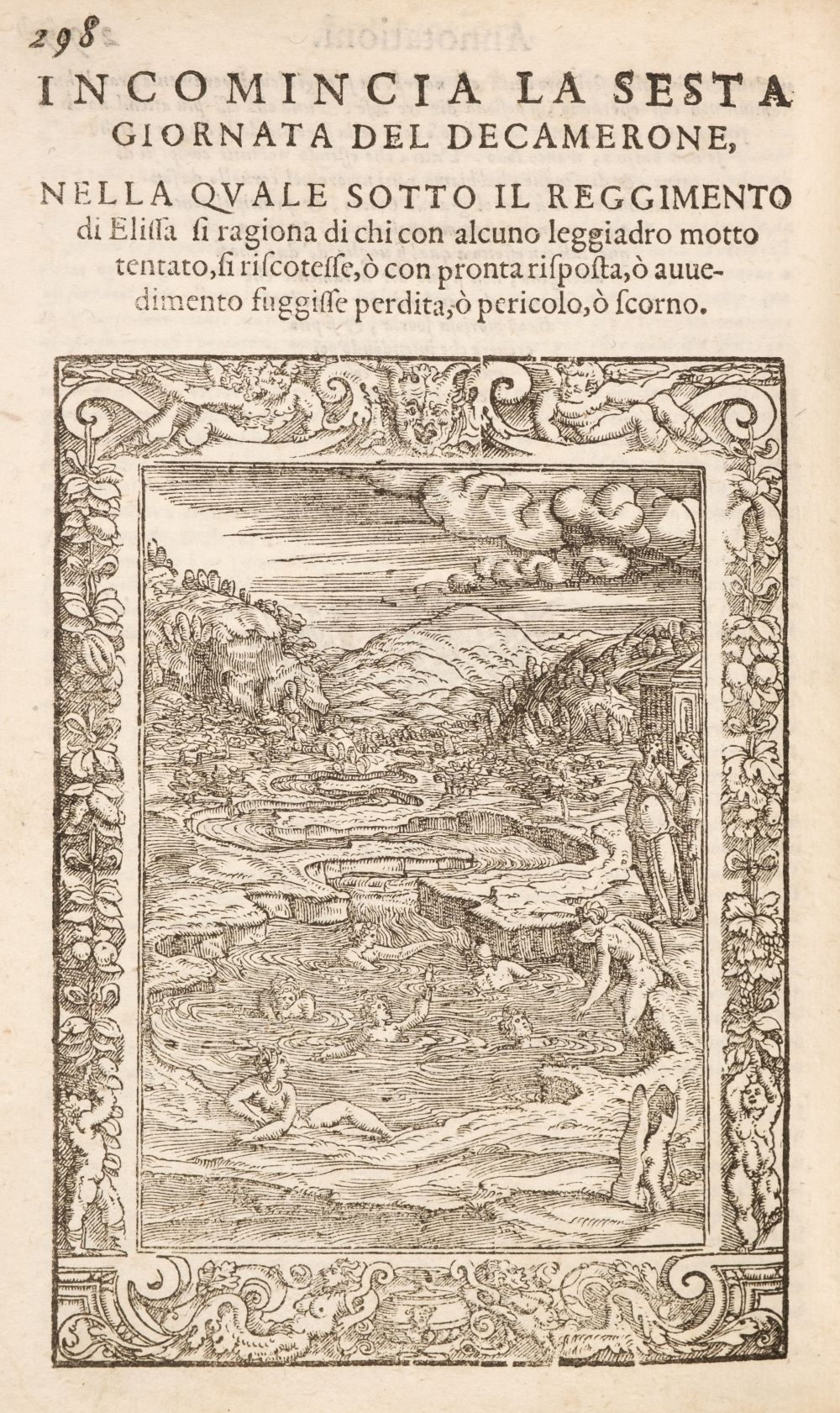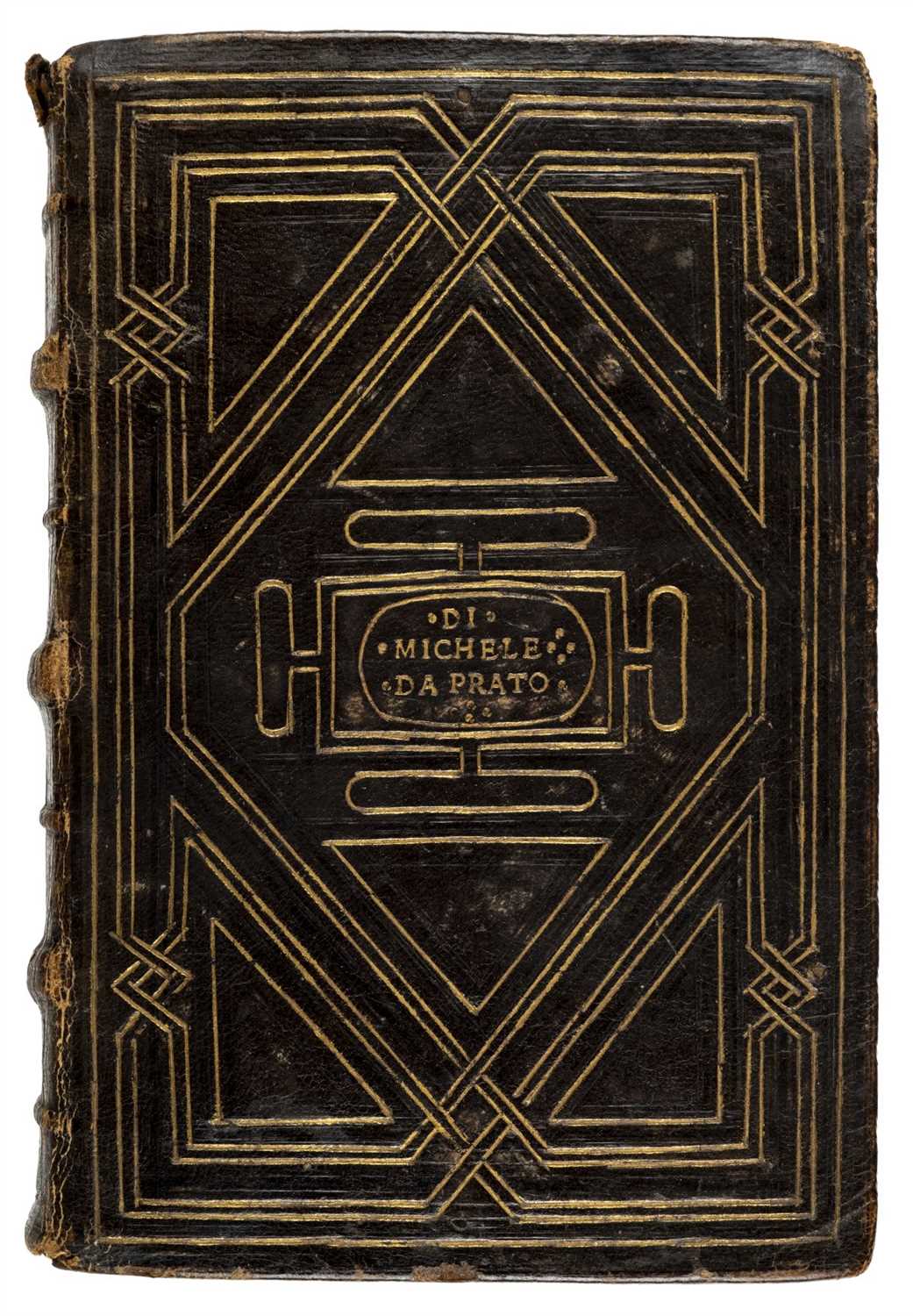Boccaccio, Giovanni. Il Decamerone di messer Giovanni Boccaccio connove e varie figure nuouamente corretto per Antonio Bruccioli. Venice: Gabriele Giolito de Ferrari & Heirs of Bernardino Stagnino, 1542
A richly tooled and painted binding by the Venetian “Fugger Binder”, a binder working closely with the publisher, Gabriele Giolito (see lot 5). Painted on the lower cover are the Medici arms (Or à cinq boules de gueules, surmontées d’un tourteau d’azur chargé de trois fleurs de lis), and the copy possibly was bound for presentation to the dauphine de France, Catherine de’ Medici.
This is the second of Giolito’s editions of the Decamerone to have annotations and commentaries tailored for the lay reader by the Florentine humanist Antonio Brucioli (1498?–1566). The previous edition had been printed by Bartolomeo Zanetti for Giovanni and Gabriele Giolito, in 1538, and dedicated by Brucioli to Luigia Pallavicini, wife of Gianfrancesco Gonzaga. This 1542 edition is dedicated by Brucioli to Maddalena Buonaiuti, daughter of Girolamo di Jacopo Buonaiuti, then a lady-in-waiting and protégée of the Dauphine Catherine de’ Medici, after 1543 the (second) wife of the poet and diplomat Luigi Alamanni. Printed with Giolito’s own materials, it features a newly cut woodcut frontispiece with medallion portrait of Boccaccio, and ten woodcuts (one for each day), executed in the fashionable “shaded” style (see Fabia Borroni Salvadori, “L’incisione al servizio del Boccaccio nei secoli XV e XVI,” in Annali della Scuola Normale Superiore di Pisa. Classe di Lettere e Filosofia, third series, 7 [1977], pp. 595–734).
By choosing female dedicatees, Brucioli and Giolito implied that the book was meant for female readers (see Androniki Dialeti, “The Publisher Gabriel Giolito de’ Ferrari, Female Readers, and the Debate about Women in Sixteenth-century Italy,” in Renaissance and Reformation 28 [2004], pp. 5–32). Giolito’s next edition of Il Decamerone, issued in 1546, sought again to engage their interest, this time with a dedication to the Dauphine herself. In that book, Giolito reminds Catherine that he had dedicated his 1542 edition of Orlando furioso to her husband, Henri II, “il più prudente et valoroso prencipe che habbia il mondo,” and says it is only just, that his new edition of the Decamerone, containing things mostly about women, and written by its author for the sake of women, should bear the name “della più nobile, della più saggia, & della piu virtuosa Signora, che Italia producesse giamai.” No copy of the 1546 edition in a presentation binding survives.
4to (215 x 147mm). Italic type, with roman, 39 lines plus headline. collation: *12 A–Z8 AA–II8 KK4: 272 leaves. Historiated woodcut title-border with medallion portrait of Boccaccio, 10 woodcut illustrations (one heading each day), numerous historiated woodcut initials, Giolito’s phoenix device on KK4v. (Some light marginal dampstaining.)
binding: Contemporary Venetian brown goatskin (223 X 152 mm), ca. 1550, by the Fugger Binder, possibly for Catherine de’ Medici, gilt fillet around sides, rectangular frame within a single gilt fillet containing gilt rose-and-staff roll on a black painted ground, gilt ivy leaf at outer angles; large gilt arabesque corner-pieces on a red painted background with a black painted border; central undulating lozenge surrounded by leafy arabesques, and with an upward and a downward finial with open leaf tools (filled with red and black paint and terminating in gilt apple tool painted in red, in center of upper cover a double gilt roundel containing “IL | DECAME | RONE” lettered in gilt on a blue background, and on the lower, a shield on a blue background containing the Medici arms, spine with 3 double bands and 4 false bands, blind guillouche across each compartment, traces of 4 pairs of fabric ties, edges gilt and gauffered, lettered “Boccaccio Italian” on lower edge. (Corners restored, extremities rubbed, gilt of edges quite rubbed.)
provenance: Evidently Catherine de’ Medici (1519–1589; painted armorial supralibros) — Giovanni Gancia, Brighton & Paris (Delbergue-Cormont & Librairie Bachelin-Deflorenne, Catalogue de la bibliothèque de M. G. Gancia composée en partie de livres de la première Bibliothèque du Cardinal Mazarin et d’Ouvrages précieux, Paris, 27 April–2 May 1868, lot 724. Purchased by) —Rouquette, Paris (FF 250) — Amédée Rigaud (1819–1873; exlibris; Cailleux & Auguste Aubry, Catalogue des beaux livres rares et précieux composant la bibliothèque de M. Amédée Rigaud, Paris, 28 April–6 May 1874, lot 808. Purchased by) — unidentified owner — Joseph Renard (1822–1882; exlibris; Maurice Delestre & Adolphe Labitte, Catalogue de livres rares et précieux imprimés et manuscrits la plupart français et latins de la bibliothèque de M. J. Renard (de Lyon), Paris, 21–30 March 1881, lot 957. Purchased by) — Froget-Pelouzac, Lyon (FF 200) — Édouard Gustave Kann (1873–1927; Fernand Lair-Dubreuil & Georges Andrieux, Paris, 14–15 November 1930, lot 27 & Pl. 7. Purchased by) — unidentified owner (FF 20,000). — Christie’s, Livres rares et Manuscrits, Paris, 3 November 2020, lot 15 (€20,000). acquisition: Purchased at Christie’s through Robin Halwas.
references: Edit16 6302; USTC 814815; Salvatore Bongi, Annali di Gabriel Giolito de’Ferrari (Rome, 1890), I, pp. 42–43; Giorgio Spini, “Bibliografia delle opere di Antonio Brucioli,” in La Bibliofilía 42 (1940), pp. 129–180 (pp. 171–172. no. 64); Mortimer, Italian, no. 70; cf. for the binding and Catherine de’ Medici provenance: Bauchart, Les femmes bibliophiles de France (XVIe, XVIIe & XVIIIe siècles) (Paris, 1886), p.100, no. 18; A. Hobson, Renaissance Book Collecting (Cambridge, 1999), p. 257 (Appendix 8: Bindings by the Fugger Binder, no. 69); Conihout & Ract-Madoux, “À la recherche de la bibliothèque perdue de Catherine de Médicis,” in Il mecenatismo di Caterina de’ Medici (Venice, 2008), pp. 39–61, 399–409 (p. 58, no. 8).
Boccaccio, Giovanni. Il Decamerone di messer Giovanni Boccaccio connove e varie figure nuouamente corretto per Antonio Bruccioli. Venice: Gabriele Giolito de Ferrari & Heirs of Bernardino Stagnino, 1542
A richly tooled and painted binding by the Venetian “Fugger Binder”, a binder working closely with the publisher, Gabriele Giolito (see lot 5). Painted on the lower cover are the Medici arms (Or à cinq boules de gueules, surmontées d’un tourteau d’azur chargé de trois fleurs de lis), and the copy possibly was bound for presentation to the dauphine de France, Catherine de’ Medici.
This is the second of Giolito’s editions of the Decamerone to have annotations and commentaries tailored for the lay reader by the Florentine humanist Antonio Brucioli (1498?–1566). The previous edition had been printed by Bartolomeo Zanetti for Giovanni and Gabriele Giolito, in 1538, and dedicated by Brucioli to Luigia Pallavicini, wife of Gianfrancesco Gonzaga. This 1542 edition is dedicated by Brucioli to Maddalena Buonaiuti, daughter of Girolamo di Jacopo Buonaiuti, then a lady-in-waiting and protégée of the Dauphine Catherine de’ Medici, after 1543 the (second) wife of the poet and diplomat Luigi Alamanni. Printed with Giolito’s own materials, it features a newly cut woodcut frontispiece with medallion portrait of Boccaccio, and ten woodcuts (one for each day), executed in the fashionable “shaded” style (see Fabia Borroni Salvadori, “L’incisione al servizio del Boccaccio nei secoli XV e XVI,” in Annali della Scuola Normale Superiore di Pisa. Classe di Lettere e Filosofia, third series, 7 [1977], pp. 595–734).
By choosing female dedicatees, Brucioli and Giolito implied that the book was meant for female readers (see Androniki Dialeti, “The Publisher Gabriel Giolito de’ Ferrari, Female Readers, and the Debate about Women in Sixteenth-century Italy,” in Renaissance and Reformation 28 [2004], pp. 5–32). Giolito’s next edition of Il Decamerone, issued in 1546, sought again to engage their interest, this time with a dedication to the Dauphine herself. In that book, Giolito reminds Catherine that he had dedicated his 1542 edition of Orlando furioso to her husband, Henri II, “il più prudente et valoroso prencipe che habbia il mondo,” and says it is only just, that his new edition of the Decamerone, containing things mostly about women, and written by its author for the sake of women, should bear the name “della più nobile, della più saggia, & della piu virtuosa Signora, che Italia producesse giamai.” No copy of the 1546 edition in a presentation binding survives.
4to (215 x 147mm). Italic type, with roman, 39 lines plus headline. collation: *12 A–Z8 AA–II8 KK4: 272 leaves. Historiated woodcut title-border with medallion portrait of Boccaccio, 10 woodcut illustrations (one heading each day), numerous historiated woodcut initials, Giolito’s phoenix device on KK4v. (Some light marginal dampstaining.)
binding: Contemporary Venetian brown goatskin (223 X 152 mm), ca. 1550, by the Fugger Binder, possibly for Catherine de’ Medici, gilt fillet around sides, rectangular frame within a single gilt fillet containing gilt rose-and-staff roll on a black painted ground, gilt ivy leaf at outer angles; large gilt arabesque corner-pieces on a red painted background with a black painted border; central undulating lozenge surrounded by leafy arabesques, and with an upward and a downward finial with open leaf tools (filled with red and black paint and terminating in gilt apple tool painted in red, in center of upper cover a double gilt roundel containing “IL | DECAME | RONE” lettered in gilt on a blue background, and on the lower, a shield on a blue background containing the Medici arms, spine with 3 double bands and 4 false bands, blind guillouche across each compartment, traces of 4 pairs of fabric ties, edges gilt and gauffered, lettered “Boccaccio Italian” on lower edge. (Corners restored, extremities rubbed, gilt of edges quite rubbed.)
provenance: Evidently Catherine de’ Medici (1519–1589; painted armorial supralibros) — Giovanni Gancia, Brighton & Paris (Delbergue-Cormont & Librairie Bachelin-Deflorenne, Catalogue de la bibliothèque de M. G. Gancia composée en partie de livres de la première Bibliothèque du Cardinal Mazarin et d’Ouvrages précieux, Paris, 27 April–2 May 1868, lot 724. Purchased by) —Rouquette, Paris (FF 250) — Amédée Rigaud (1819–1873; exlibris; Cailleux & Auguste Aubry, Catalogue des beaux livres rares et précieux composant la bibliothèque de M. Amédée Rigaud, Paris, 28 April–6 May 1874, lot 808. Purchased by) — unidentified owner — Joseph Renard (1822–1882; exlibris; Maurice Delestre & Adolphe Labitte, Catalogue de livres rares et précieux imprimés et manuscrits la plupart français et latins de la bibliothèque de M. J. Renard (de Lyon), Paris, 21–30 March 1881, lot 957. Purchased by) — Froget-Pelouzac, Lyon (FF 200) — Édouard Gustave Kann (1873–1927; Fernand Lair-Dubreuil & Georges Andrieux, Paris, 14–15 November 1930, lot 27 & Pl. 7. Purchased by) — unidentified owner (FF 20,000). — Christie’s, Livres rares et Manuscrits, Paris, 3 November 2020, lot 15 (€20,000). acquisition: Purchased at Christie’s through Robin Halwas.
references: Edit16 6302; USTC 814815; Salvatore Bongi, Annali di Gabriel Giolito de’Ferrari (Rome, 1890), I, pp. 42–43; Giorgio Spini, “Bibliografia delle opere di Antonio Brucioli,” in La Bibliofilía 42 (1940), pp. 129–180 (pp. 171–172. no. 64); Mortimer, Italian, no. 70; cf. for the binding and Catherine de’ Medici provenance: Bauchart, Les femmes bibliophiles de France (XVIe, XVIIe & XVIIIe siècles) (Paris, 1886), p.100, no. 18; A. Hobson, Renaissance Book Collecting (Cambridge, 1999), p. 257 (Appendix 8: Bindings by the Fugger Binder, no. 69); Conihout & Ract-Madoux, “À la recherche de la bibliothèque perdue de Catherine de Médicis,” in Il mecenatismo di Caterina de’ Medici (Venice, 2008), pp. 39–61, 399–409 (p. 58, no. 8).















Testen Sie LotSearch und seine Premium-Features 7 Tage - ohne Kosten!
Lassen Sie sich automatisch über neue Objekte in kommenden Auktionen benachrichtigen.
Suchauftrag anlegen